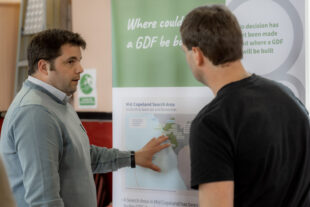
Nuclear Waste Services has started its initial investigations to begin to understand the suitability of hosting a Geological Disposal Facility (GDF) in Mid Copland. The desk-based studies will look at the feasibility of delivering a surface facility connected to the geology of interest off the coast.
The developer will lead the studies and draw upon a wider supply chain of specialist contractors to conduct non-intrusive and desk-based studies in all of the Community Partnership areas.
We asked Barnaby Hudson, Mid Copeland’s Siting Manager at Nuclear Waste Services (NWS), some questions about the studies.
What are site evaluation studies?
A range of studies will be undertaken in each of the Community Partnership areas to look at where a surface site, underground accessways and associated development for a GDF might be located.
The first studies will address priority topics, and further studies will be considered. The feasibility studies are expected to inform decisions about whether an area should proceed to further site characterisation. The studies are likely to be ‘desktop’ studies looking in more detail at existing data.
What are the initial studies you are carrying out in Mid Copeland?
The initial studies are in these areas:
- Geology – Collating existing information about geology in the Mid Copeland Search Area and the adjacent inshore area to provide an increased understanding of geology to help support further local studies. Seismic data collected last summer will be included when processed.
- Accessways (Tunnels) – Accessways is the underground tunnels or shafts which link a surface site to a disposal location. This will include looking at engineering feasibility such as number of accessways which could be required and appropriate mining methodology.
- Initial Transport Study – Gathering existing information about local transport to assess how a GDF may use the current transport infrastructure and consider what potential upgrades may be required.
- Utilities (power) – Identifying power infrastructure and capacity to understand local supply and assess how a GDF may influence future demand.
- Implications of local geology – Consider the implications of local geology which may influence the engineering requirements and design of a GDF to ensure safe and secure dispose of radioactive waste.
- Higher activity waste disposal – Consider the implications of local geology which may influence the disposal requirements and design of a GDF to ensure safe and secure disposal of radioactive waste.
- Labour and skills – Identifying local skills levels to assess how a GDF may influence future employment and training opportunities.
- Future investigations – Identifying the deep borehole drilling techniques and investigations which could be used in the local area.
- Land – understand potential local land requirements to support early engagement and raising awareness of future GDF investigations
- Proximity to nuclear licensed sites – Understanding any operational requirements from an existing nuclear licensed site which may have an influence on the operations of a GDF.
How long will the studies take?
The studies will vary in duration and topic but are expected to be completed in all areas within 2-3 years of them starting. The results of some studies will come sooner than others.
Why haven’t you started these studies earlier?
In the last 18 months NWS has been preparing for Site Evaluation work in terms of learning lessons from Site Evaluation activities in other countries, engaging and selecting an expert supply chain to support this work.
Who is doing the studies?
NWS will lead the studies and draw upon a wider supply chain of specialist contractors to conduct non-intrusive and desk-based studies in all of the CP areas.
Do the Community Partnerships decide what studies are done?
NWS, as developer, needs to consider a range of factors. The Community Partnerships have been briefed on the programme of studies. The Community Partnerships will be kept up to date about technical work carried out by NWS.
Which studies do you expect to complete first?
It’s too early to say, but we will be keeping Community Partnerships updated on progress.
Were last year’s geophysical surveys off Copeland part of this work?
The marine geophysical survey off the coast of South and Mid Copeland was an important early step in beginning to understand the deep geology beyond the coast. The information, when available, will help us to further consider the suitability of the geology beneath the seabed to host a GDF and detailed analysis of the data collected from the surveys will inform the evaluation of sites.
When are the results of the Copeland geophysical surveys expected?
Data acquired in the seismic survey is being processed, which takes nine months. It will then be interpreted by geoscientists, taking an additional four months, meaning results will not be available for NWS to assess until the later part of 2023.
Recent Comments